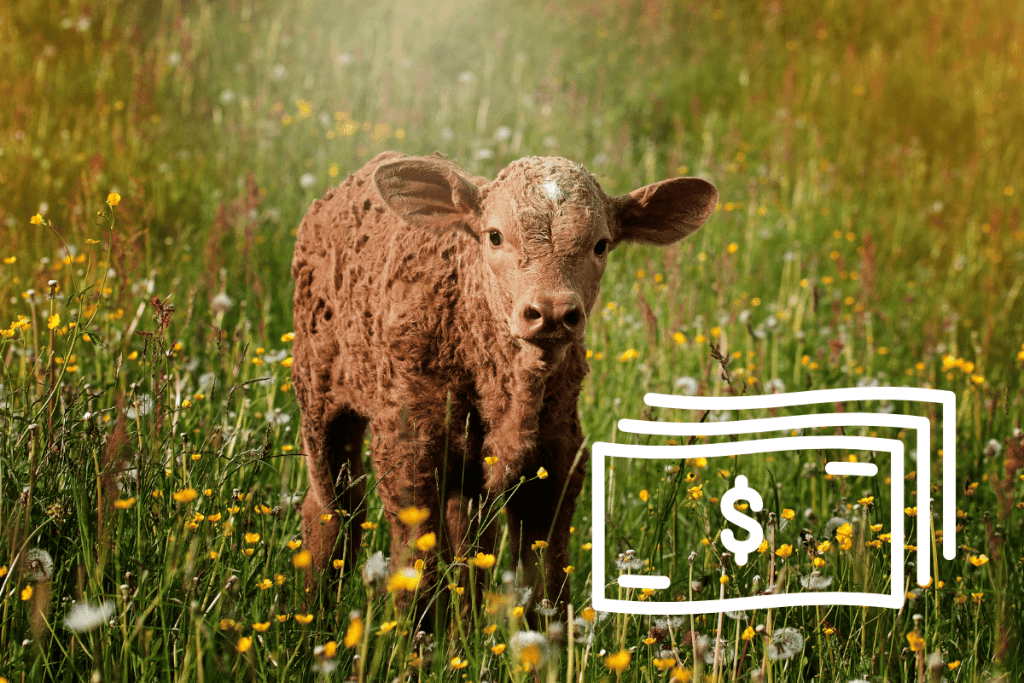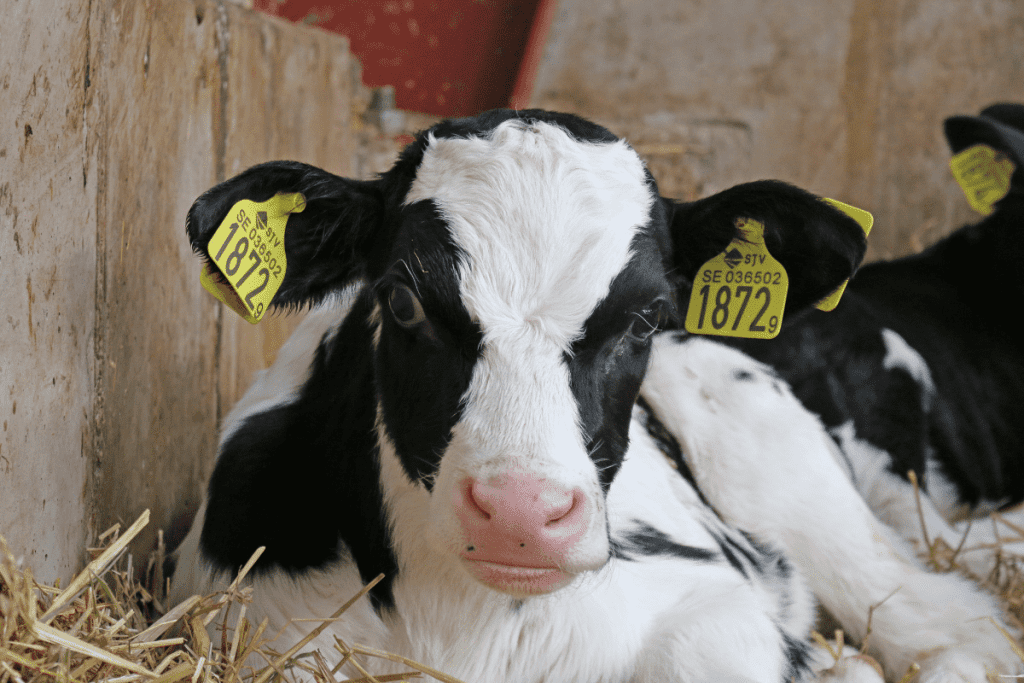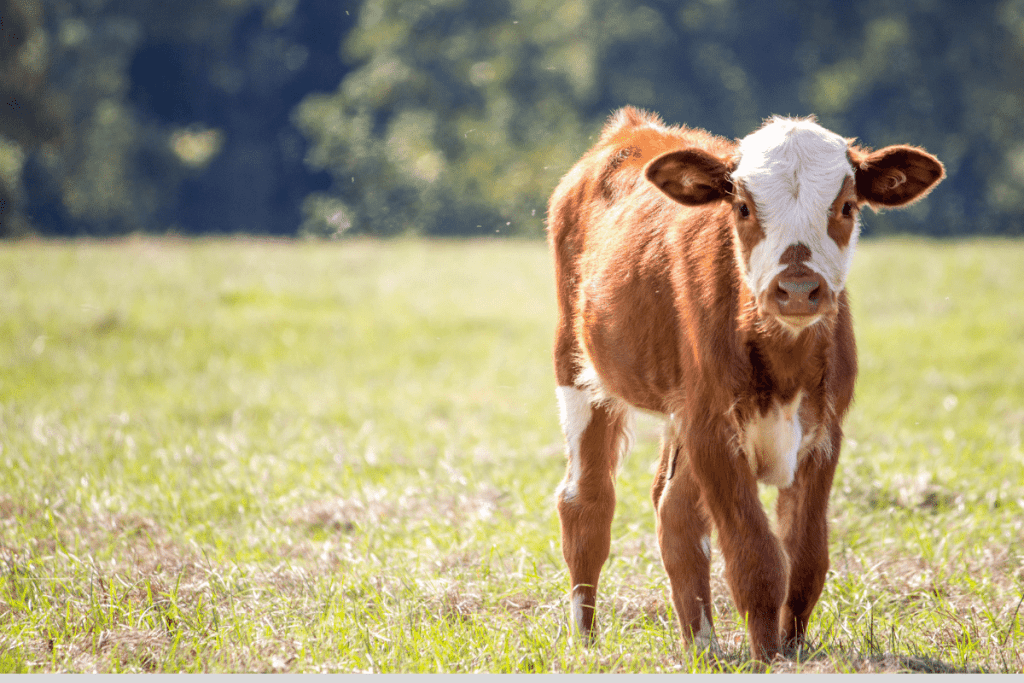If you are considering purchasing calves and raising them yourself, you are probably wondering how much it costs to do so.
Luckily, we’ve done the calculations for you, so you don’t have to!
Calves themselves cost at least $550 and should be purchased in pairs. Additionally, fencing for the two acres of necessary land for two cows can cost up to $4,000. There are also many variable ongoing costs of keeping calves, such as veterinary visits and food, which can add up to $200 per month.
Keep reading to get deeper into the production costs of buying and raising calves.
We’ll cover start-up costs and ongoing costs of raising calves and answer some frequently asked questions about raising calves.

Table of Contents
ToggleHow Much Does it Cost to Buy and Raise Calves?
Initial Costs of Purchasing Calves
If you breed your calves yourself, there is little to no cost associated with acquiring calves outside of breeding costs.
However, if you are purchasing calves, they are pretty expensive.
The younger a calf is, the cheaper it will be, but caring for young calves is also more time-consuming.
The best calves to buy for beginners are yearlings, which are 4-6 months old.
Cost per cow prices for cattle such as these range from a base price of $550 to $700 depending on whether they are meat calves or dairy calves, with dairy calves being cheaper.
The average price of older calves is higher depending on their weight, running up to around $1,000.
Bigger calves are more expensive because calves are typically sold by weight, meaning a larger cow costs more than a smaller cow.
Because cows are herd animals, it is essential to purchase at least two calves at a time so they can feel secure with each other on the farm.
This means purchasing your initial calves will be at least $1,100 and higher if you purchase older calves or meat calves.
Pasture Costs
In addition to purchasing the calves themselves, you will also need to ensure they have adequate pasture and housing.
This cow cost is highly variable depending on whether you already own a barn and how much land you possess.
If you need to purchase land in addition to the calves themselves, it will be much more expensive than if you already own pasture land, which is ready for cows.
You’ll need at least 1.5 acres per cow for them to live happy lives.
Related: How many cows fit on 5 acres?
Fencing is another major cost associated with owning cows.
Cattle fencing can cost up to $2.50 per linear foot, which adds up quickly when you have to fence in acres and acres of land.
It takes about one acre of land per calf, and it is important to buy cows in pairs or larger groups because they are herd animals.
Therefore, you’ll need to fence in at least two acres of land for your calves to thrive.
Land costs are a big part of the initial cost of keeping calves.
It takes about 835′ linear feet of fencing to enclose one acre, so you’ll need around 1,600′ linear feet of fencing for two acres.
This puts your fencing cost upwards of $4,000.
Installing fencing is a great expense when it comes to raising calves.
Related: How many joules on an electric fence for cattle?
Monthly Costs of Owning Calves
One of the most critical overhead costs of owning calves and a standard cost of production is veterinary visits.
Veterinary visits can run around $100 per calf, and calves should be seen every two or three months to check for intestinal parasites and other health conditions and administer vaccines.
Assuming a calf sees the veterinarian every three months, the average monthly cost of veterinarian visits is around $33.
The feed cost is an additional cost when it comes to raising calves.
Calves eat about 2.5% of their body weight in dry food each day, meaning a 600-pound calf will eat up to 18 pounds of dry matter each day.
A 1,000-pound calf will eat up to 25 pounds of dry matter each day.
The cost per pound for alfalfa hay is typically around $0.20.
So, a month of hay for a 1,000-pound calf will cost about $150, and the daily feed cost for a 1,000-pound calf is $5.
Additionally, you may spend some money on the annual cost of upkeep and maintenance of your fencing and barn space.
These are variable costs depending on how much damage your fencing and barn incur during the year.
These features of your farm should be inspected on at least a yearly basis.
How Much Does It Cost From Birth To One Year Old To Raise A Calf?

Assuming you already have cows producing calves, and you have pasture and barn space ready for your calves, how much will it cost to raise them for one year?
An average number will be about $2,000-$2,500 for the cost of production for a single calf for one year, taking into account feeding needs and veterinary visits.
Remember, the larger calves get, the more they need to eat, increasing the cost of food each month.
How Fast Do Cows Grow?
Calves can see more than a pound of gain per day, making them fast growers, with a calf gaining an average of 1.6 pounds per day until they are around twelve months old.
This means they reach almost 600 pounds by the time they are a year old.
Is It Profitable To Raise Calves?
It is profitable to raise calves if it is done properly.
Because calves are sold fairly young for meat or breeding purposes, there is profit in raising calves.
Larger amounts of calves increase profit because you reduce costs and increase income by keeping several or many calves.
Of course, this doesn’t mean you ought to go out and buy 50 calves.
It’s essential to only buy as many calves within your budget.
However, a 40-cow farm will inevitably pull in more profit than a 2-cow farm.
How Do You Make Profit by Raising Calves?
People raise calves for profit in several ways.
One way is to raise calves to sell later for meat or breeding purposes to other farmers.
Another way of making a profit from your calves is to let them grow up and start to produce milk, which is then sold in its original form or used to make cheeses and heavy cream.
Why Do People Raise Calves?
People raise calves for many reasons, from their companionship to raising a beef cow or milk production.
Some people raise calves simply to feed their own families, while some people raise many cows to turn a profit.
Your reasons for owning calves will determine how many and what kind of calves to purchase.
How Much Space Do Calves Need?
How much space cow-calf producers need depends on their age.
Calves up to two months old require as little as 24′ square feet per animal to be healthy.
As they grow, they require more space, with year-old calves requiring 40′ square feet per animal.
This is not including pasture space if your cows are grazing and being fed grain.
Most cow-calf producers require pasture space to live healthy lives, and each calf requires about an acre of pasture space for adequate food and exercise.
Is It Better To Buy Or Raise Heifers?
When deciding whether to buy or raise heifers, several factors to consider.
Primarily, how much time one is willing to put into one’s herd is essential.
Calves require more time and labor than adult heifers, especially when they are very young.
However, calves are often much cheaper than adult heifers, by thousands of dollars.
In some ways, this can make purchasing calves rather than heifers cheaper overall, depending on how much time and effort you have to spend on your calves.
Where Should You Buy Cows Or Calves?
The most reliable place to buy a cow or calf is a reputable, local cow owner.
Such people often have cows they are willing to sell to make a profit.
It is best to inspect the farm the cows are coming from for signs of disarray or poor hygiene, as these factors can clue you into potential health issues of the cows.
It is also possible to purchase cows from auctions or trade shows, but this option does not allow you to know as much about the cows before you purchase them.
However, auctions and trade shows are an excellent way to purchase cows because you do have the opportunity to inspect the cows themselves.
What Do Calves Eat?
Calves are fed whole or pasteurized waste milk early in their lives to meet their nutritional needs.
The performance of calves is closely tied to how much mother’s milk, or colostrum, they consume early in life.
Feeding only pasteurized waste milk and not colostrum will not be good for calves.
The supply of waste milk can come from milk unsuitable for sale but still safe for calves to drink.
Once they are weaned from the milk, which usually happens around 7-8 months of age, calves eat just like adult cows, graze on grass and legumes, and eat hay or grain, depending on the goals of the cow’s owner.
Cows intended for meat tend to be fed more grain because it makes them grow larger faster, while dairy cows tend to eat more grass and legumes than meat cows.
Related: How fast do cows grow to full size?
What Is A Heifer Calf?
A heifer calf is a young female calf, typically one who has not yet been weaned from milk.
Heifers are female cows who have not yet been bred or given birth.
Once a heifer gives birth, she becomes a full-grown cow.
What Are Common Health Issues Of Calves?

Young calves’ three most important health concerns are pneumonia, diarrhea, and septicemia.
Pneumonia
Pneumonia is inflammation of the lungs, typically due to infection or bacteria.
Signs of pneumonia include a dry cough, fever, nasal discharge, anorexia, and general respiratory distress.
Pneumonia is treated with antibiotics, but even antibiotics cannot always cure pneumonia.
There are no vaccines for pneumonia, and calves who develop chronic pneumonia rarely recover.
This makes it very important to prevent and treat pneumonia carefully.
Pneumonia risks are increased by:
- Warm housing without adequate ventilation
- Lack of immunity which is transferred from colostrum early in life
- Exposure to adult cattle which can carry viruses and bacteria which can infect young calves
Diarrhea
Diarrhea, caused by many different bacteria, parasites, and viruses, is the most common cause of death in calves.
Diarrhea is a special concern when calves are less than one month of age, as this is when it most commonly occurs.
Symptoms include:
- Watery feces
- Dehydration
- Loss of appetite
Ultimately, if untreated, the condition leads to an inability to stand or be conscious.
It is vital to ensure calves get enough colostrum early in their lives to prevent diarrhea from developing.
Colostrum is the first milk produced after a female cow gives birth, and it is full of constituents that aid calves in becoming immune to many diseases and bacteria.
If a calf does not receive enough colostrum, it will be more vulnerable to various diseases, including diarrhea.
There are many causes of diarrhea in calves, most of which are vaccinated against and prevented by early colostrum feeding.
Some common causes of diarrhea include salmonella, E. coli, rotavirus, coronavirus, and C. perfringens.
Veterinarians can take stool samples to identify what is causing diarrhea and find an appropriate course of treatment.
If untreated, diarrhea in calves can often lead to death.
Septicemia
Septicemia is a blood disease that often results from a bacterial infection taking hold in utero or during birth.
Survival rates for septicemia are very low, so it is essential to prevent septicemia in cows by feeding the calves enough colostrum early in their lives.
Is it Hard to Raise Calves?
Raising calves is fairly simple but may be difficult for a first-time cattle farmer.
It is essential to learn from fellow farmers to prevent mistakes and give your calves the best life they can have.
Raising calves does not have to be hard and is often incredibly rewarding.
Cows are very docile, friendly animals and can add value and amusement to anyone’s life.
Is it Expensive to Raise Calves?
The cost of owning calves is relatively high, but so is the return in profit if calves are farmed correctly.
Depending on the type of calf you have and what kind of health conditions you encounter in your calves along the way, the cow cost may be less or more than what this article has indicated.
How useful was this post?
Click on a star to rate it!
We are sorry that this post was not useful for you!
Let us improve this post!
Tell us how we can improve this post?
